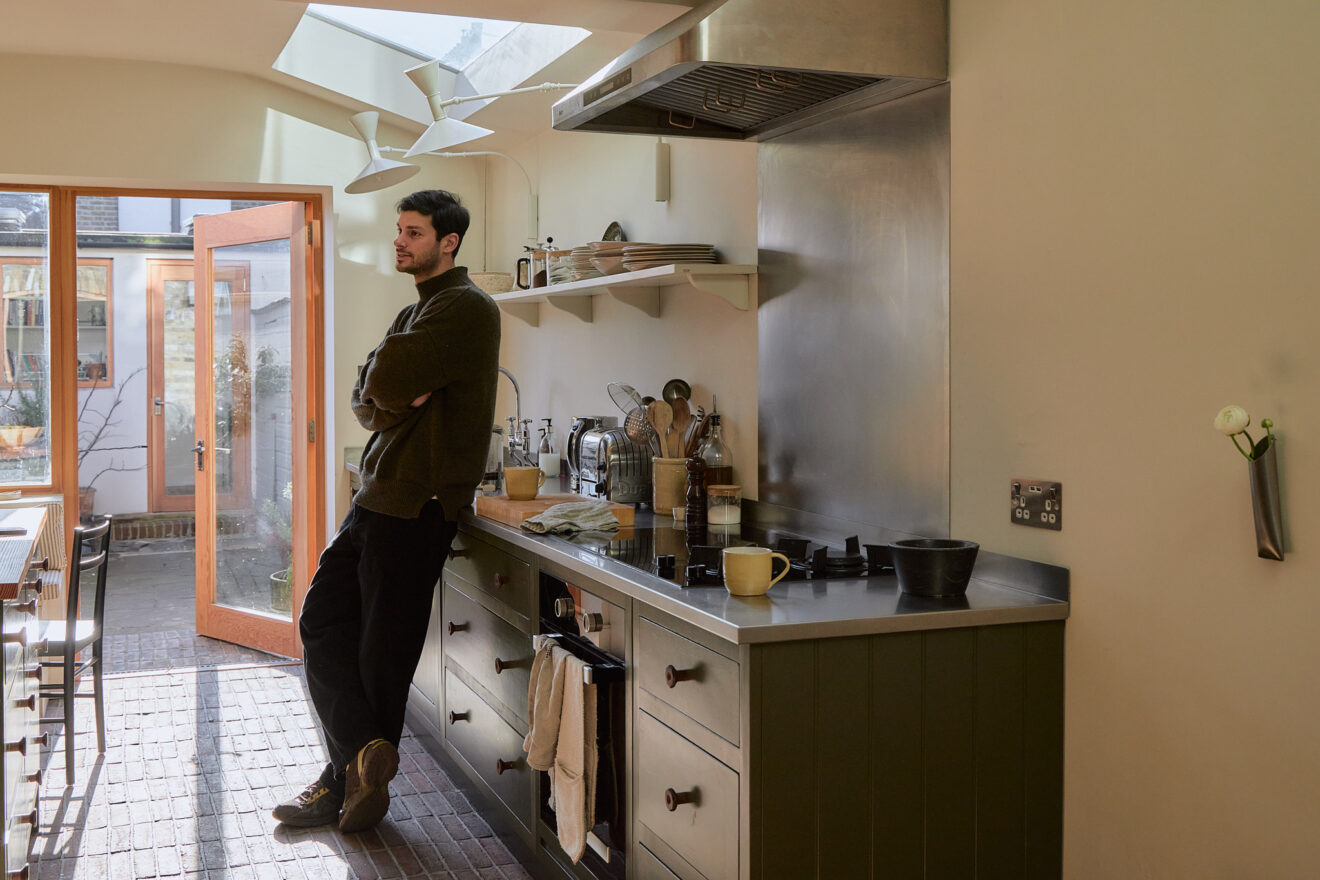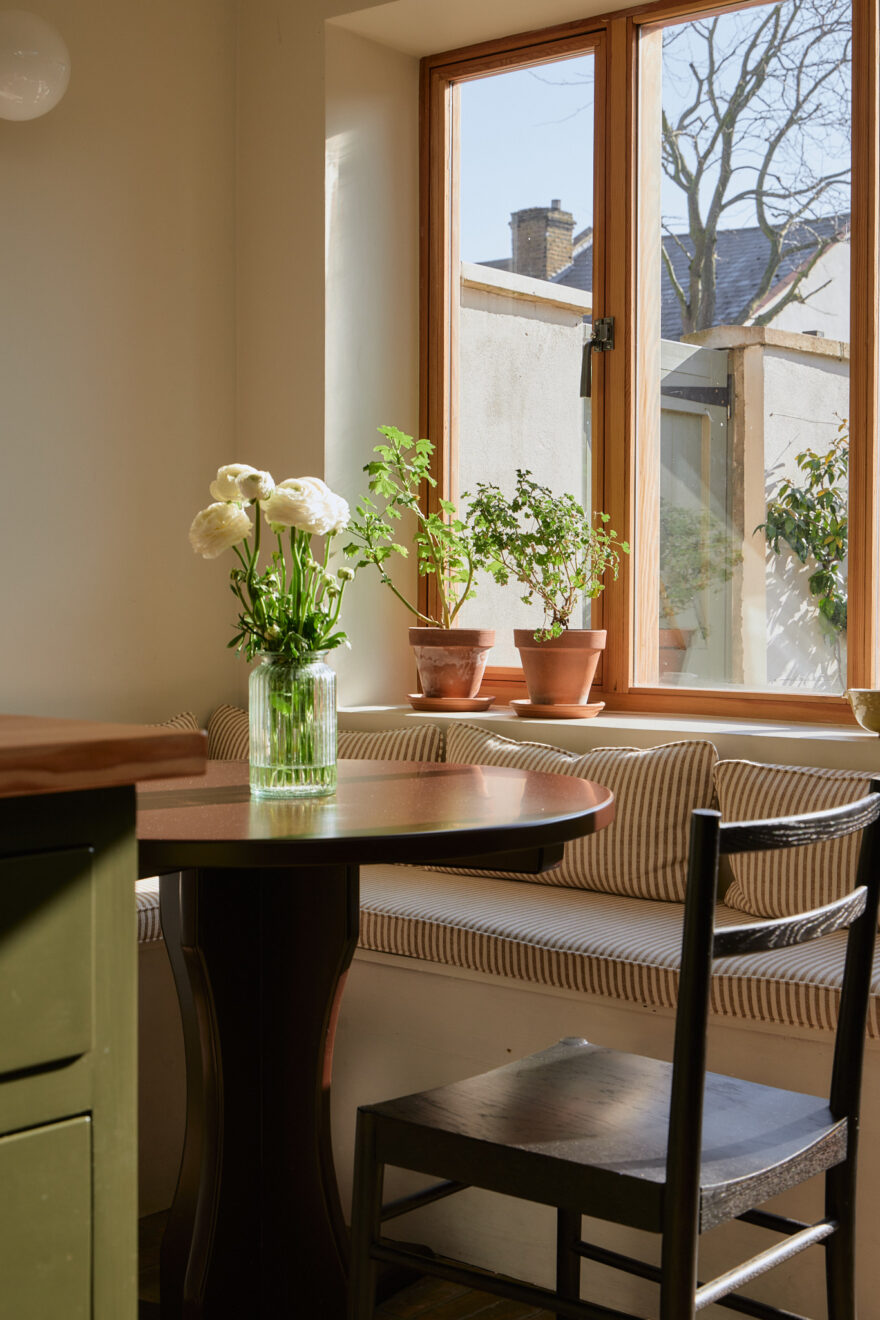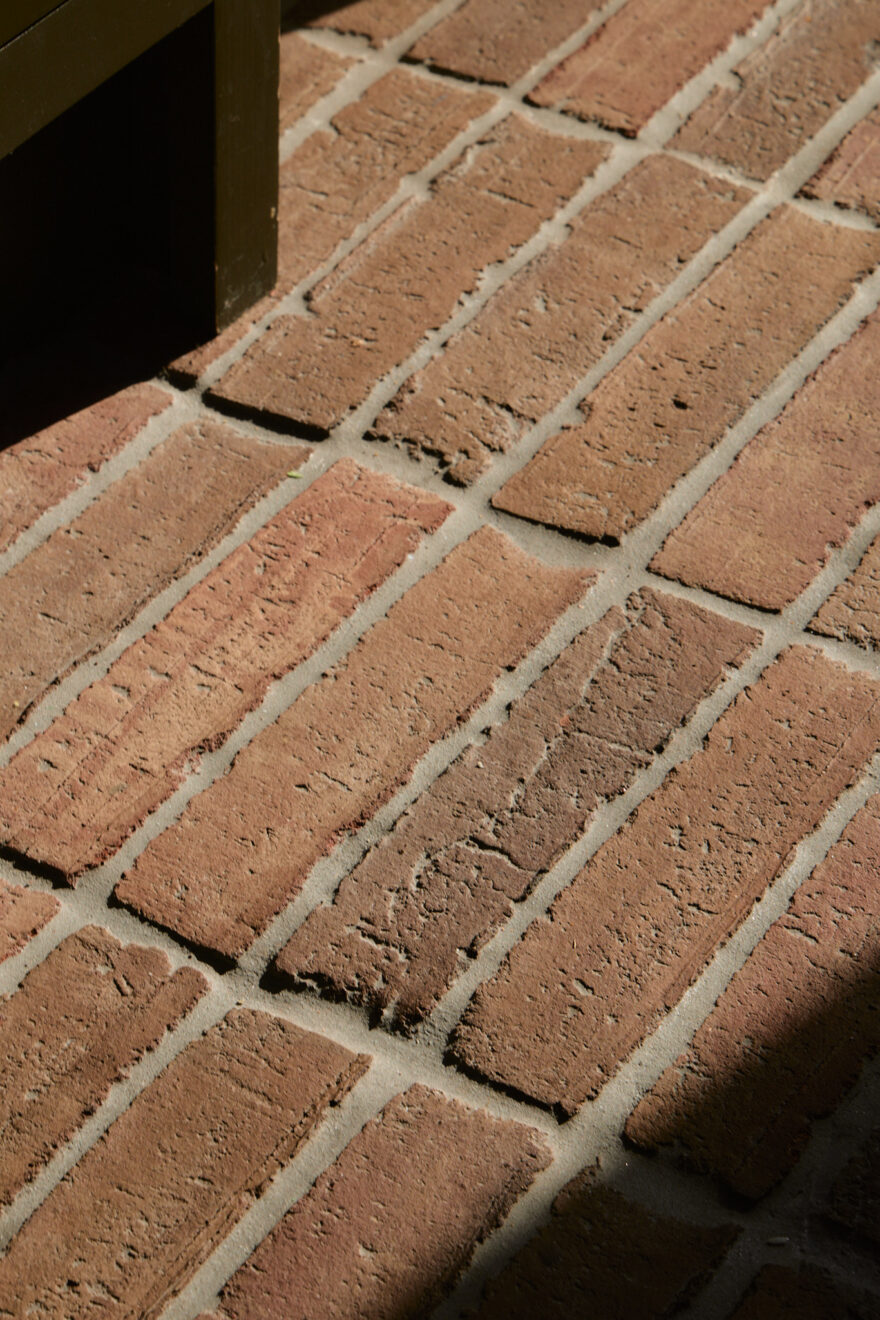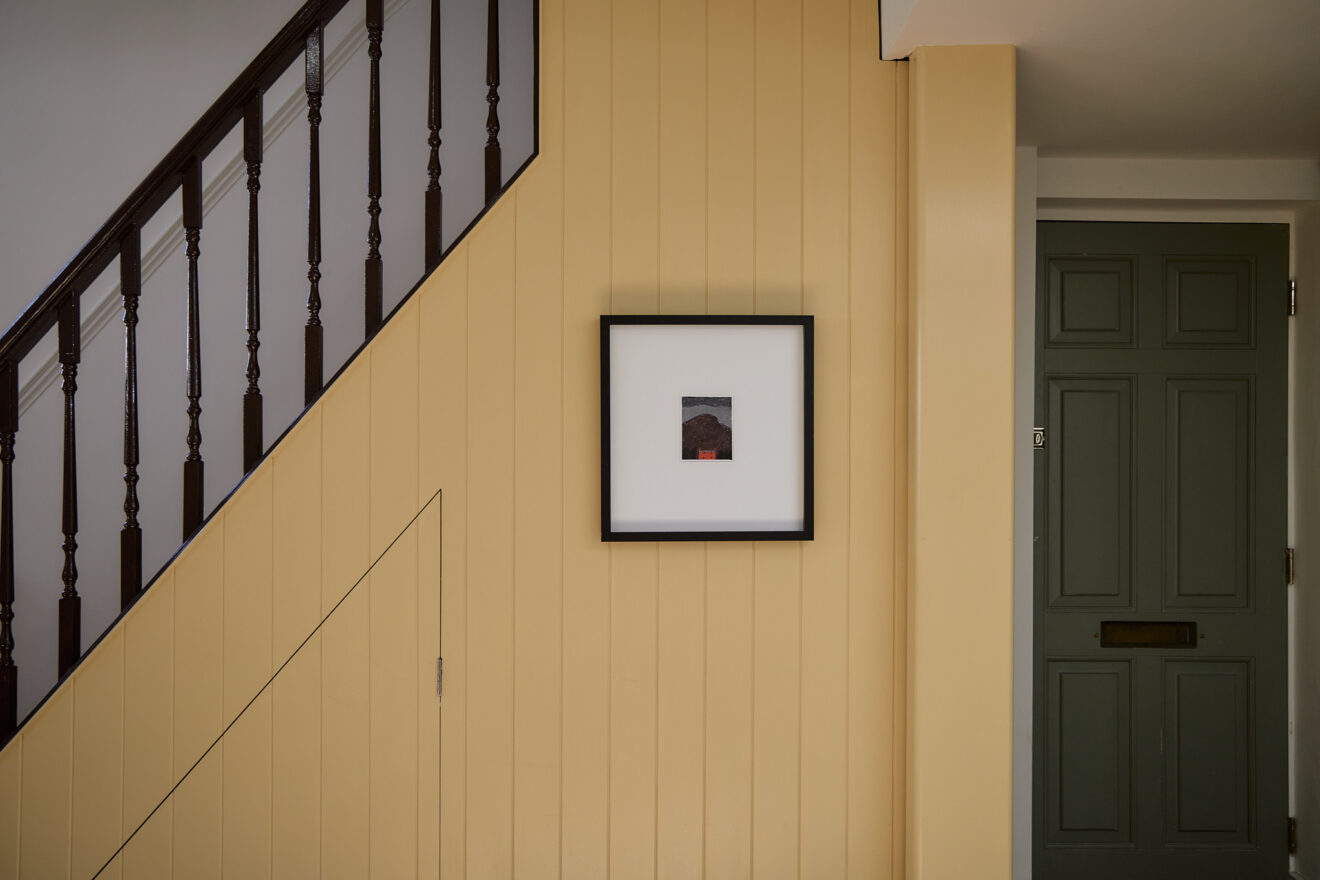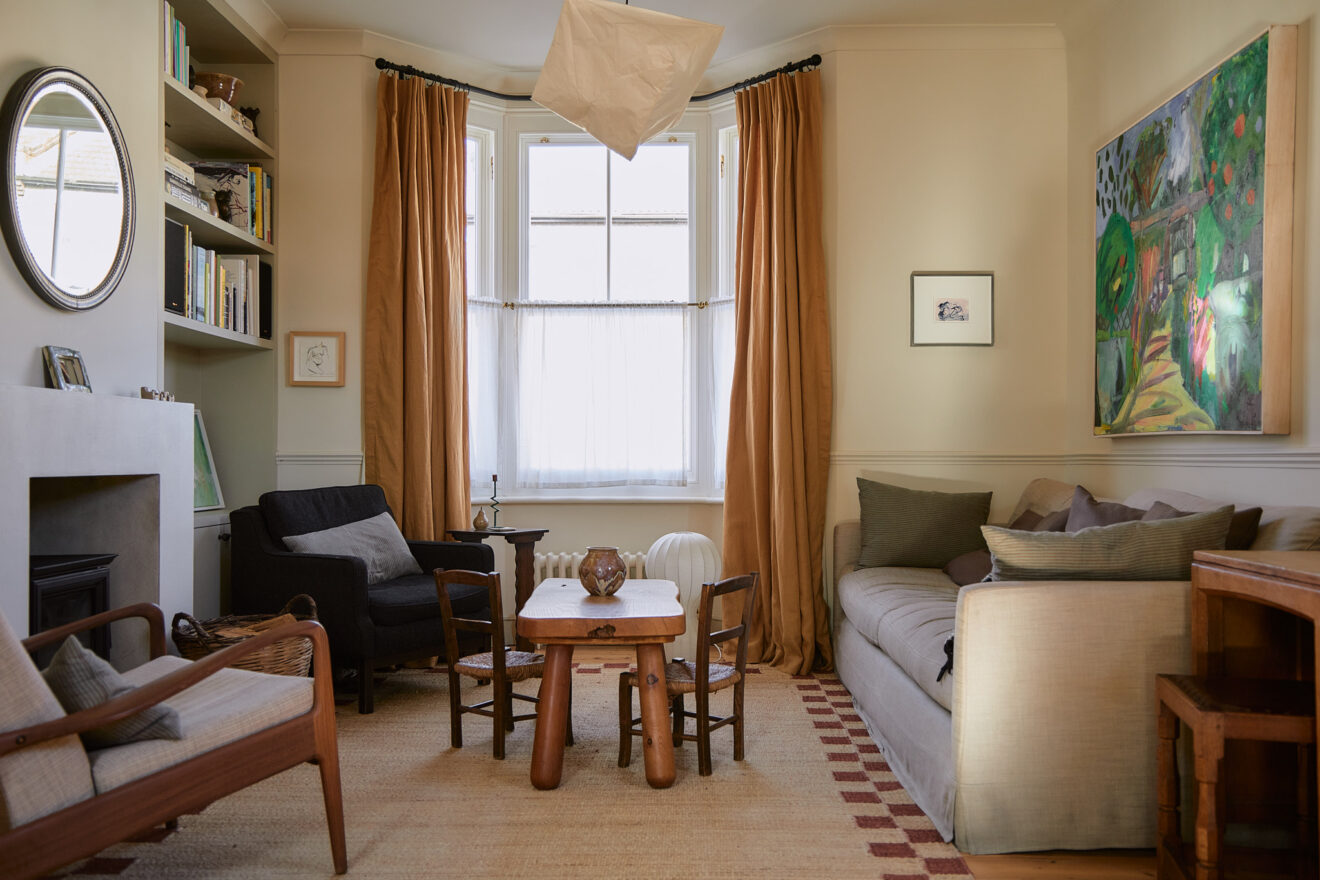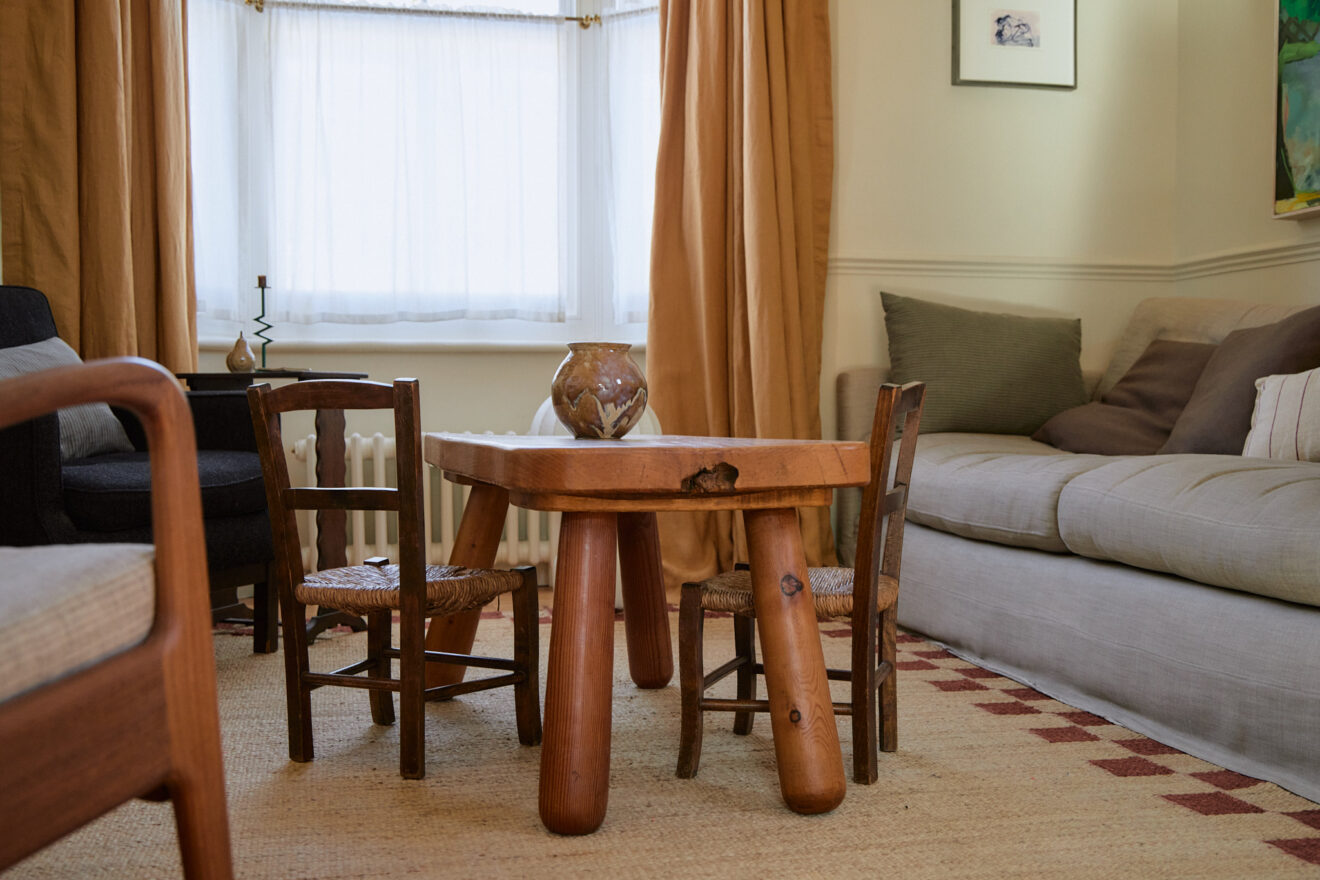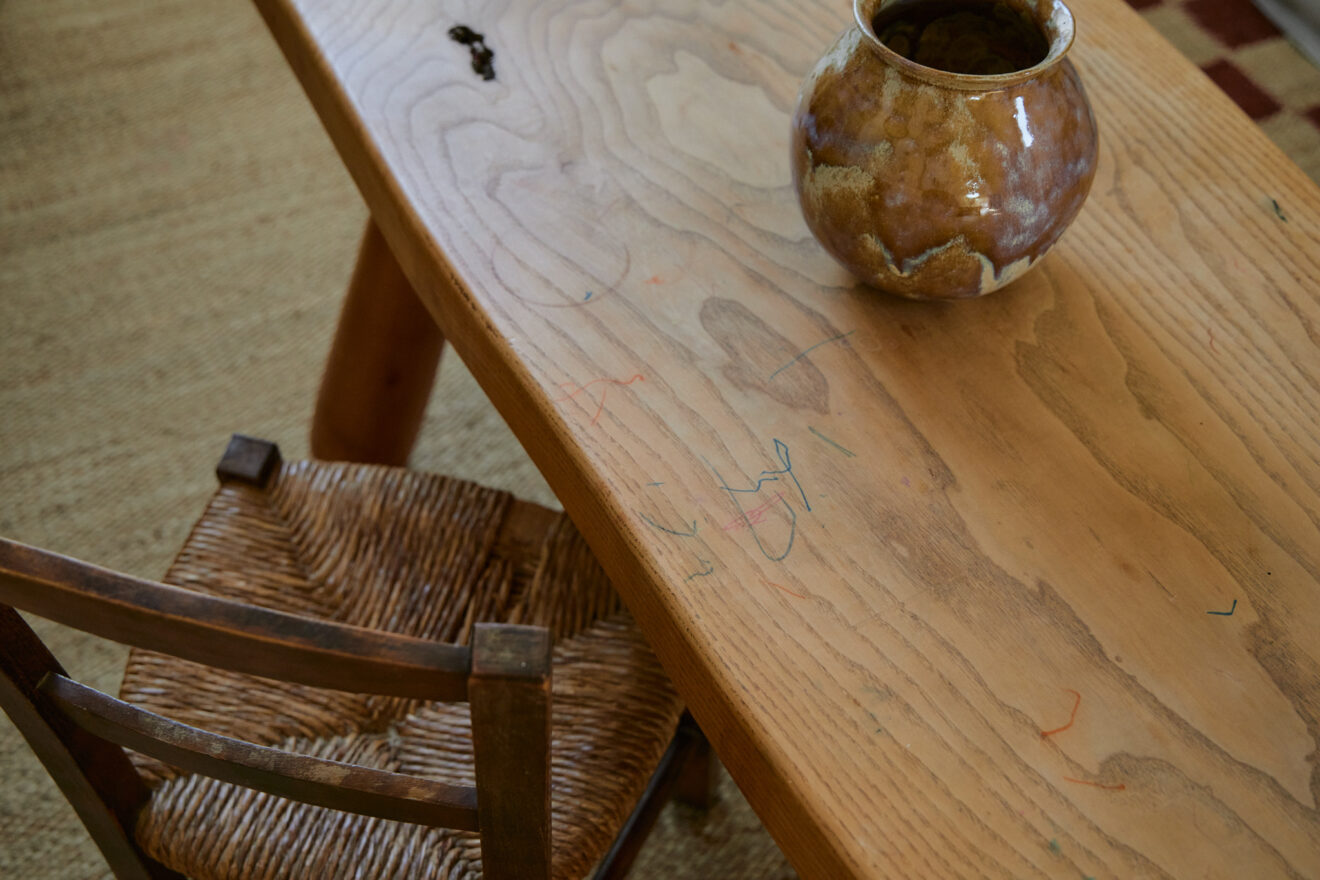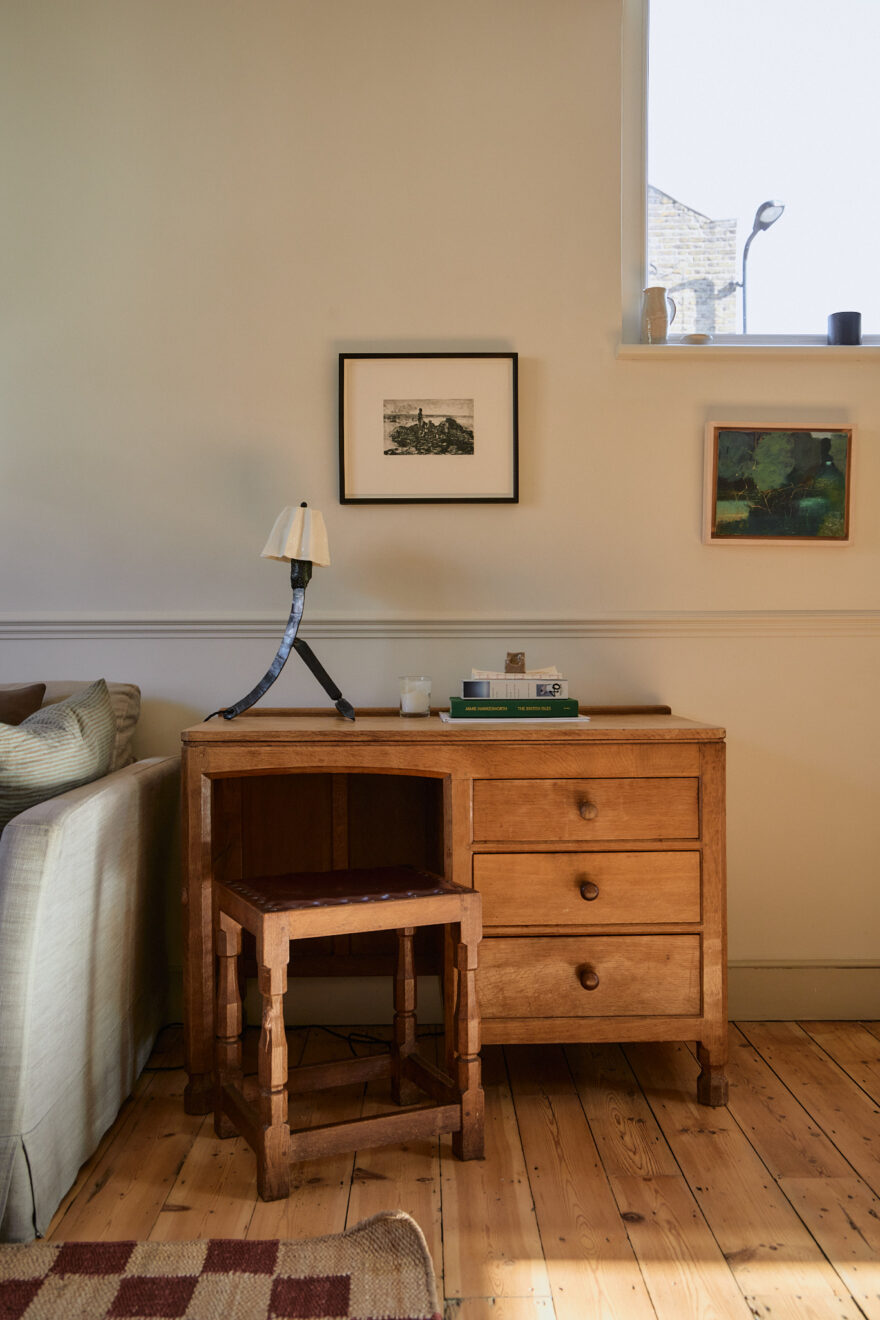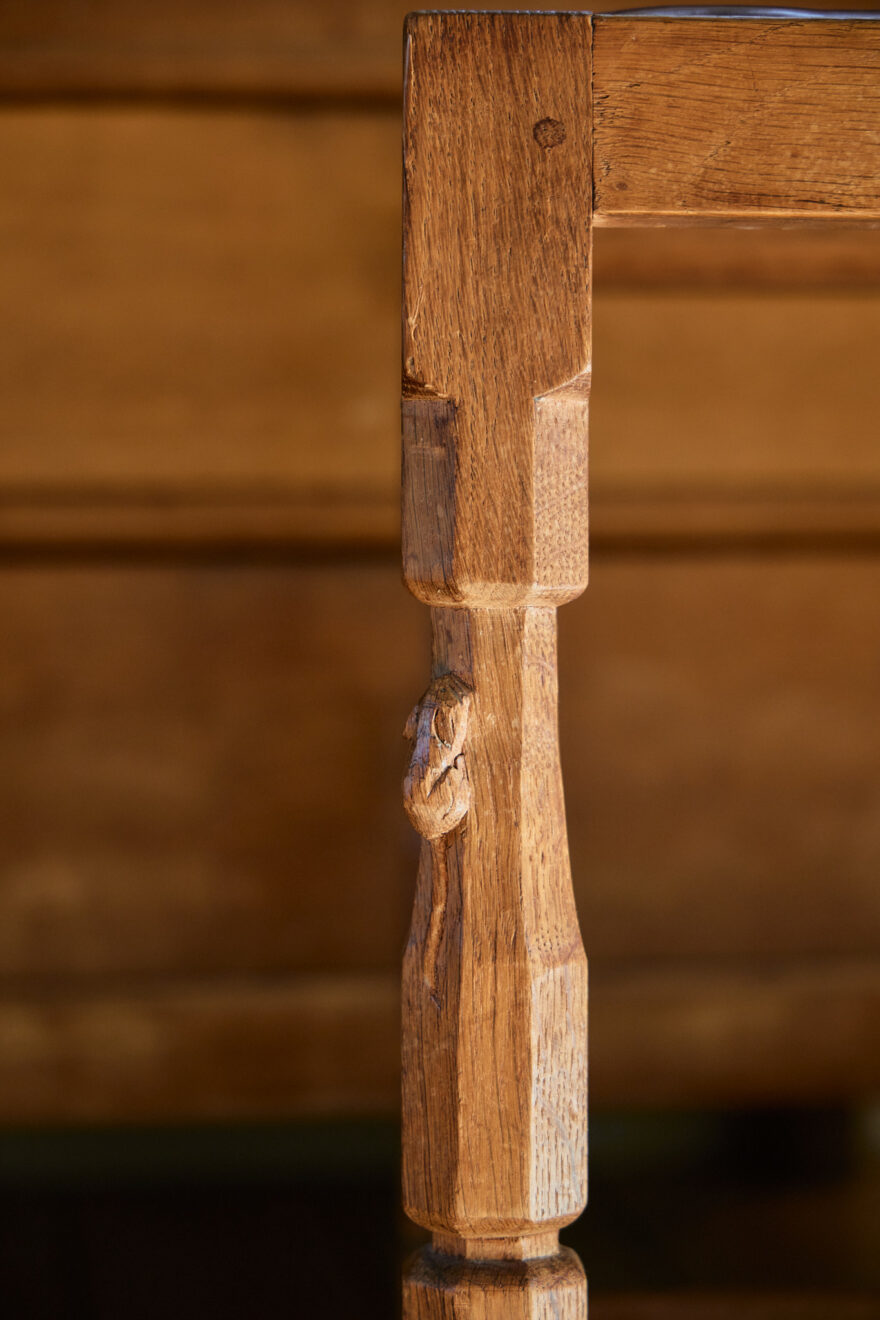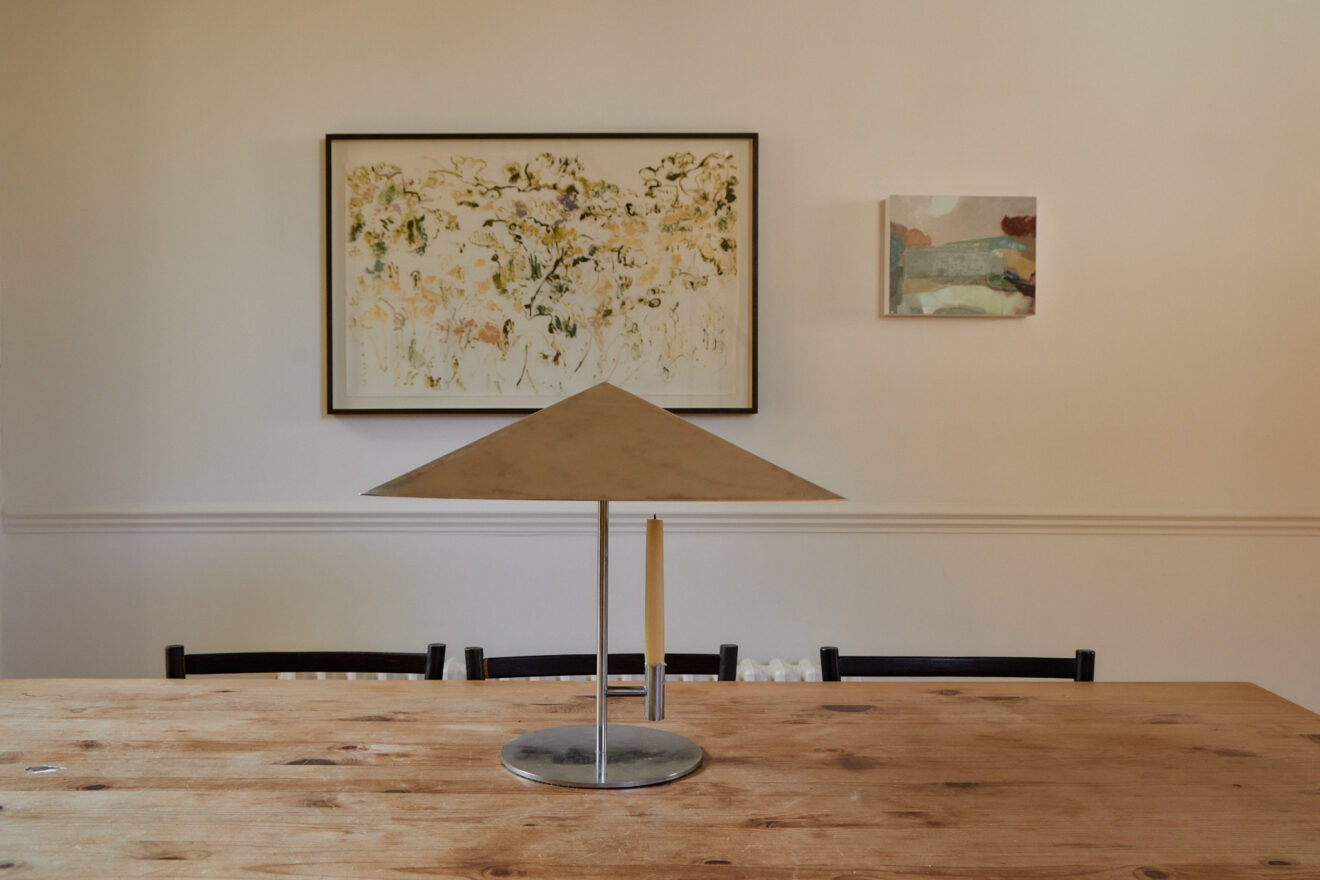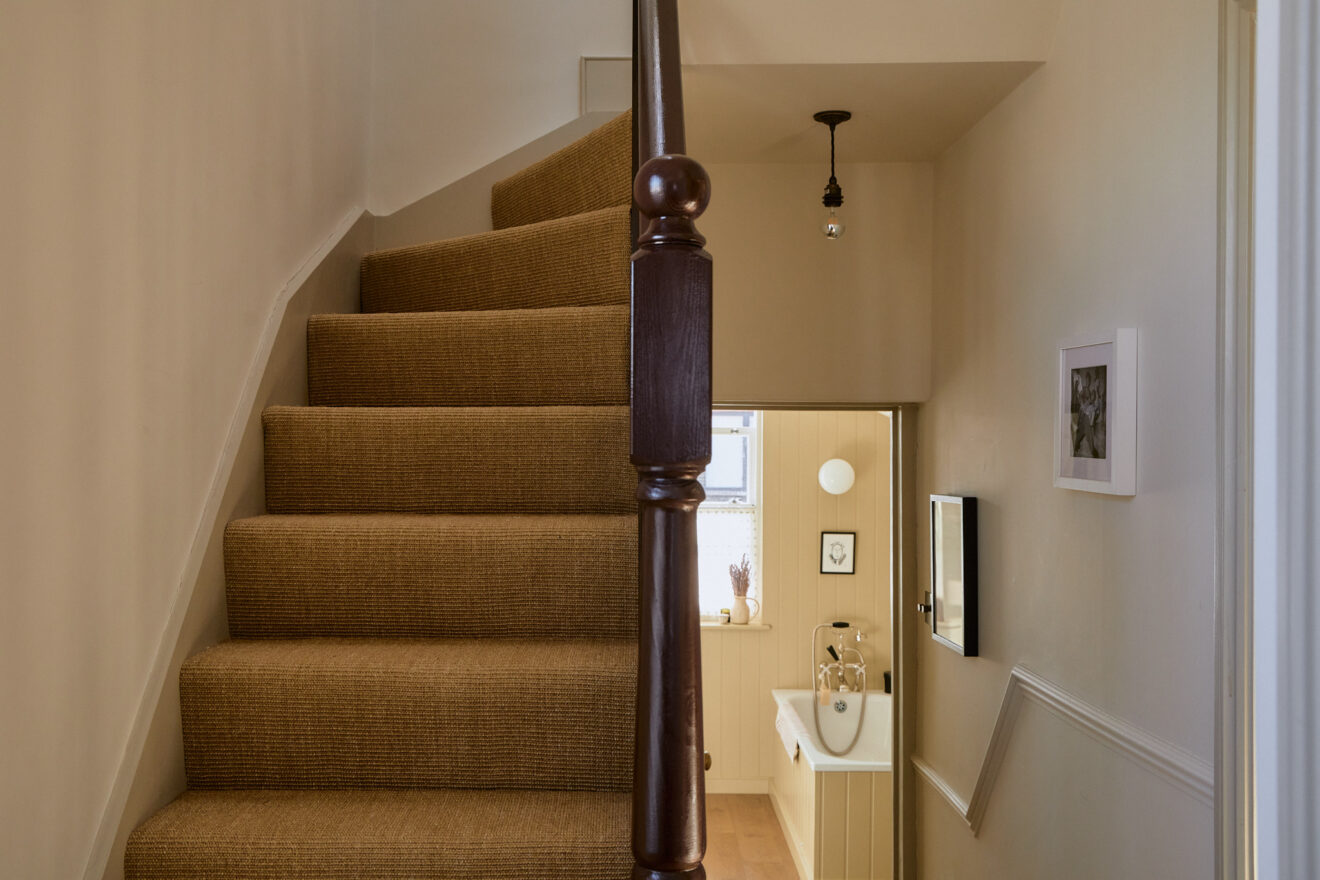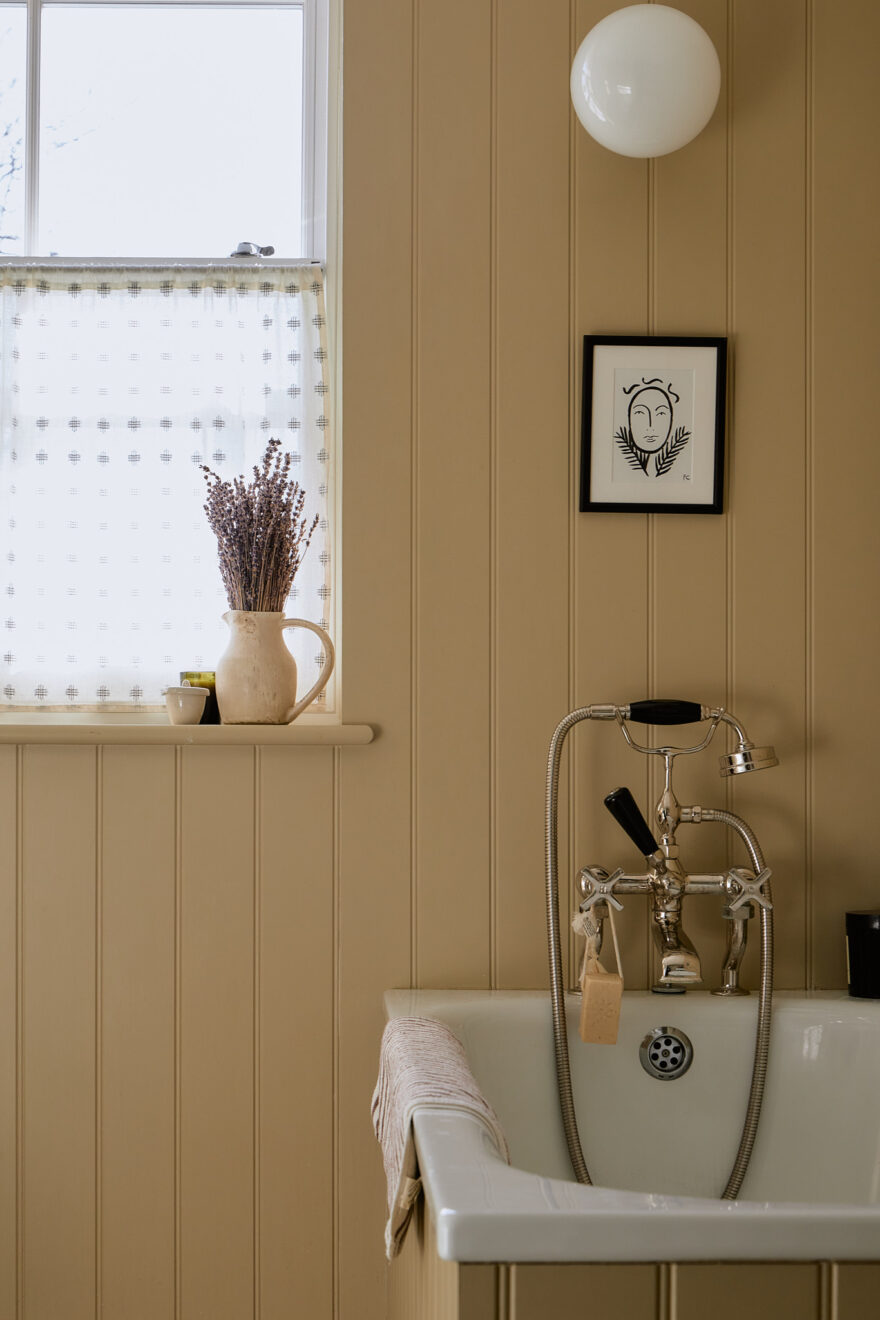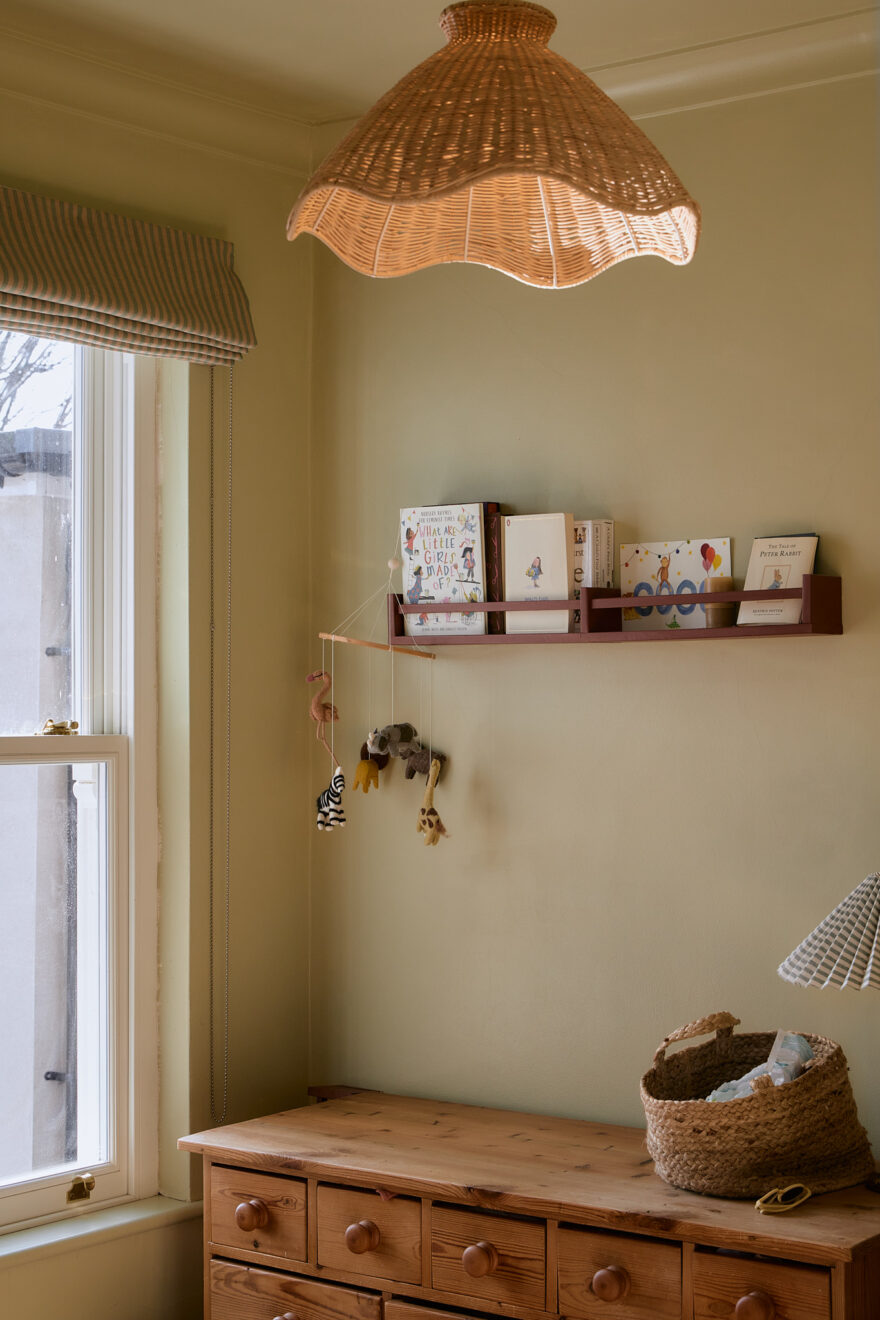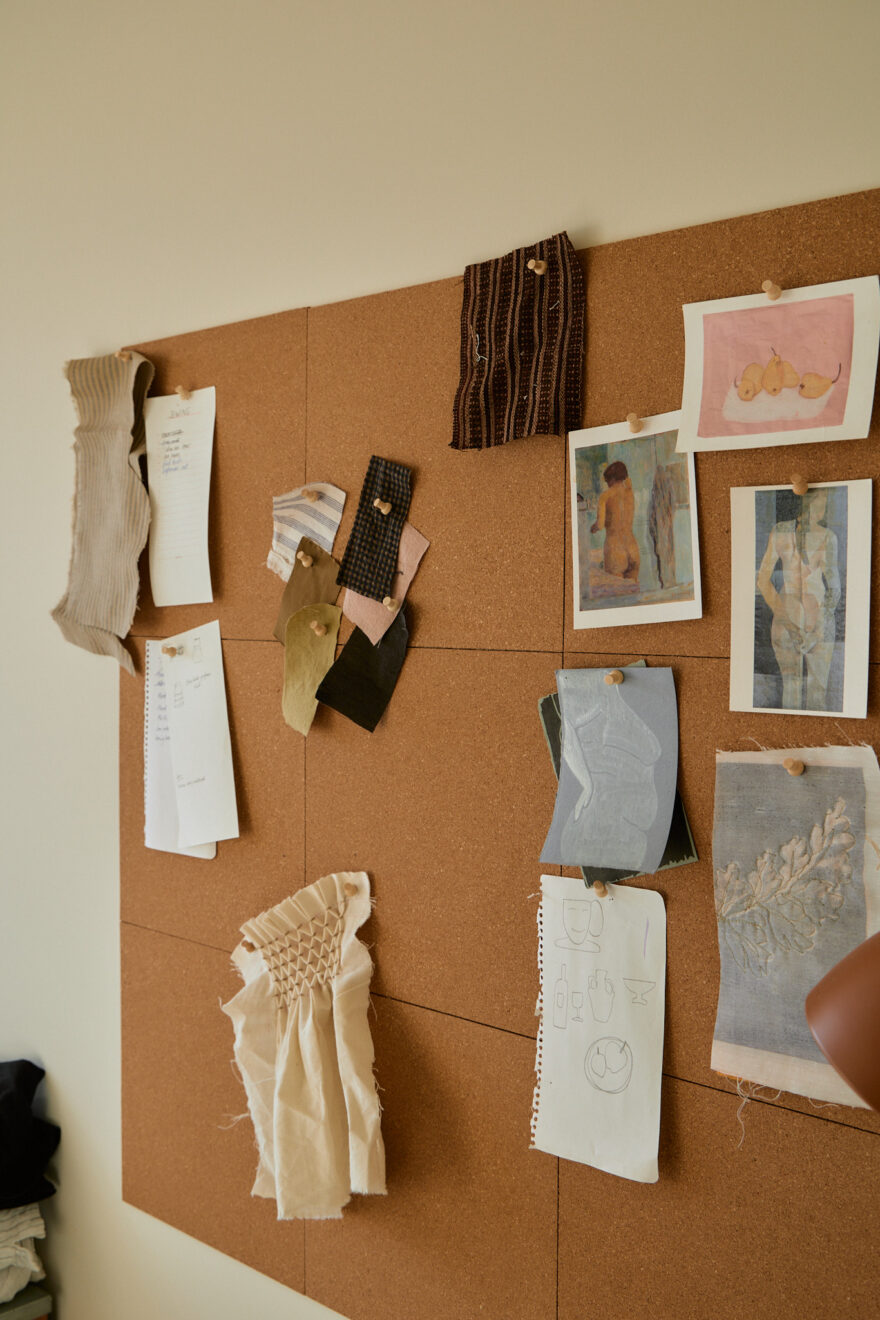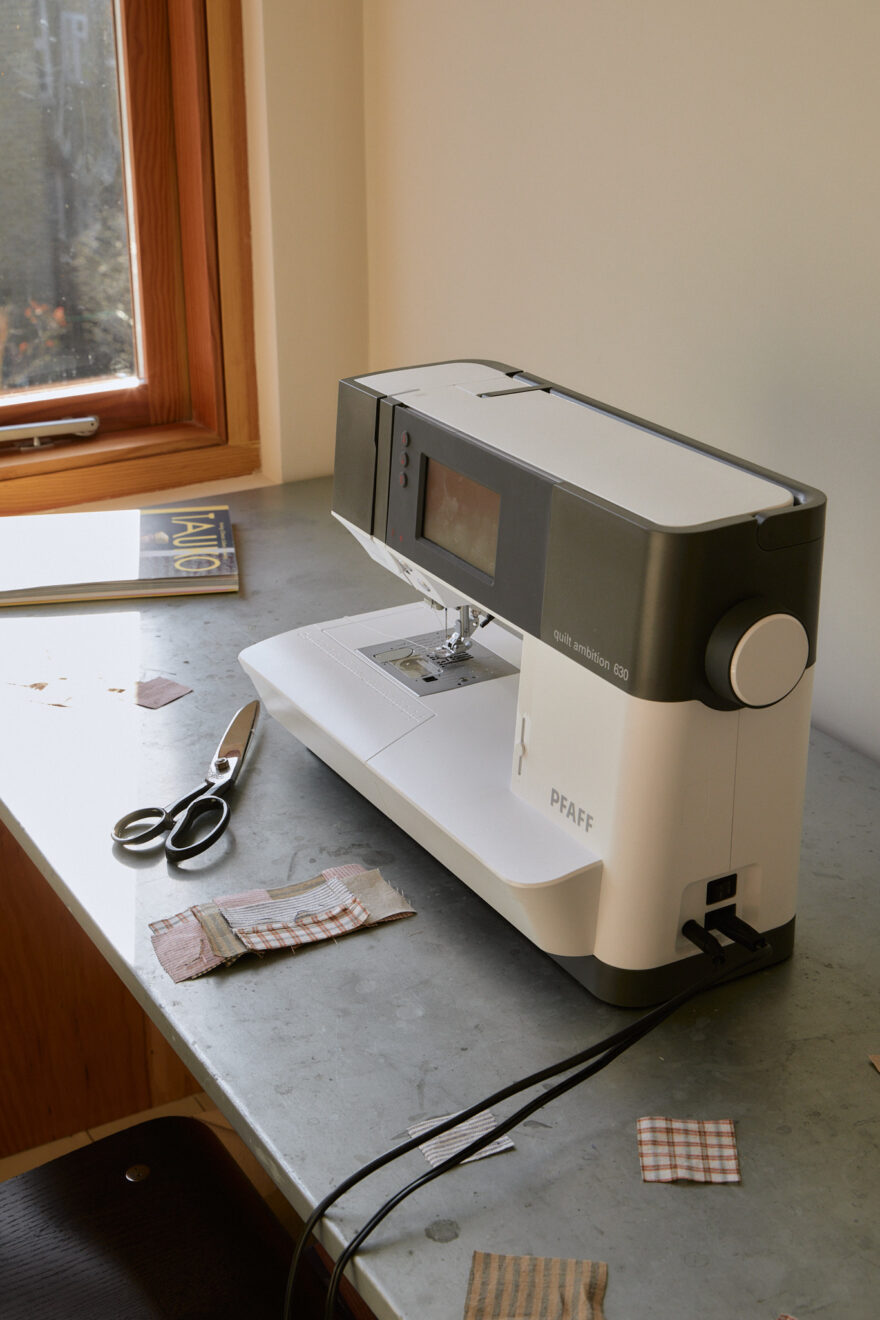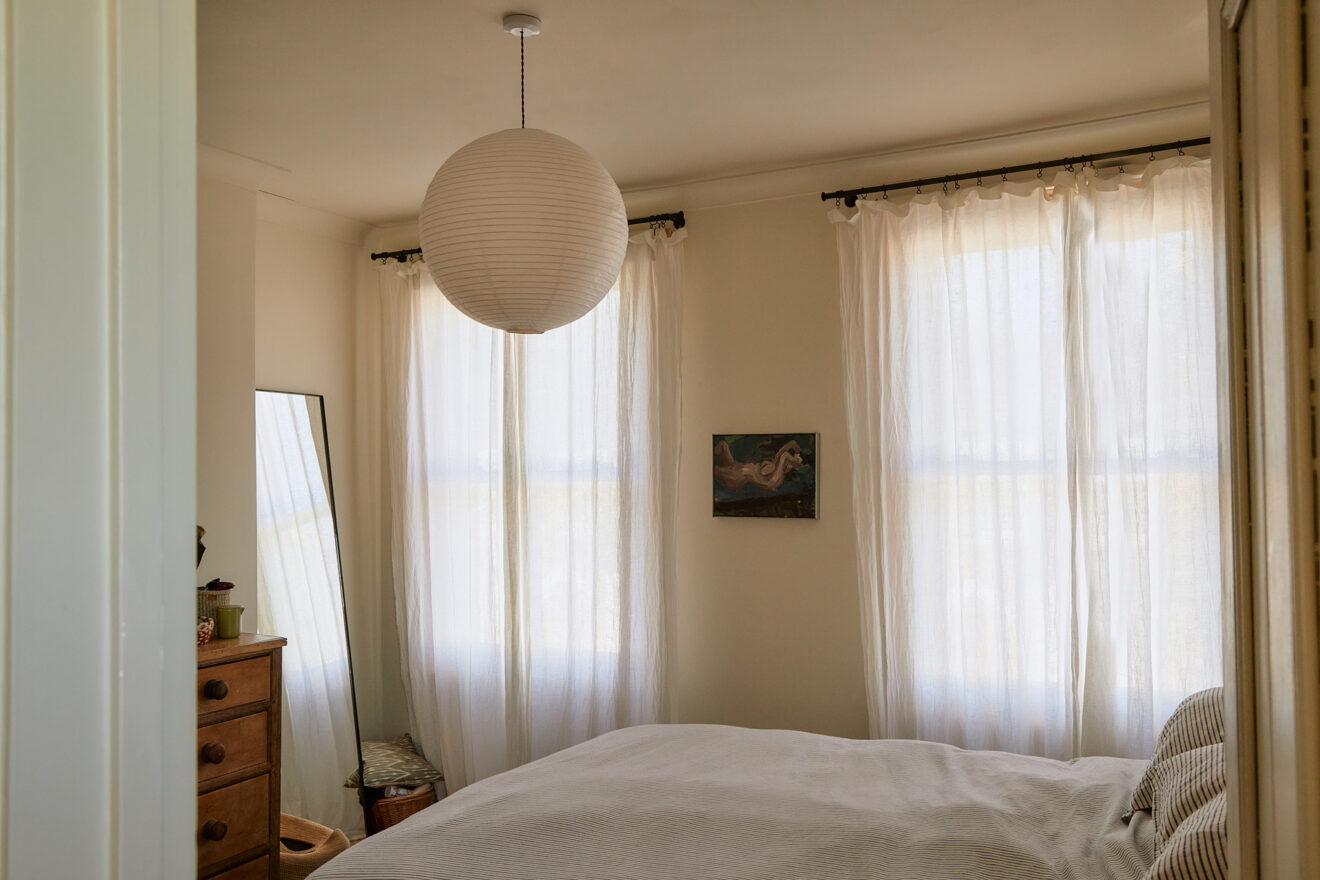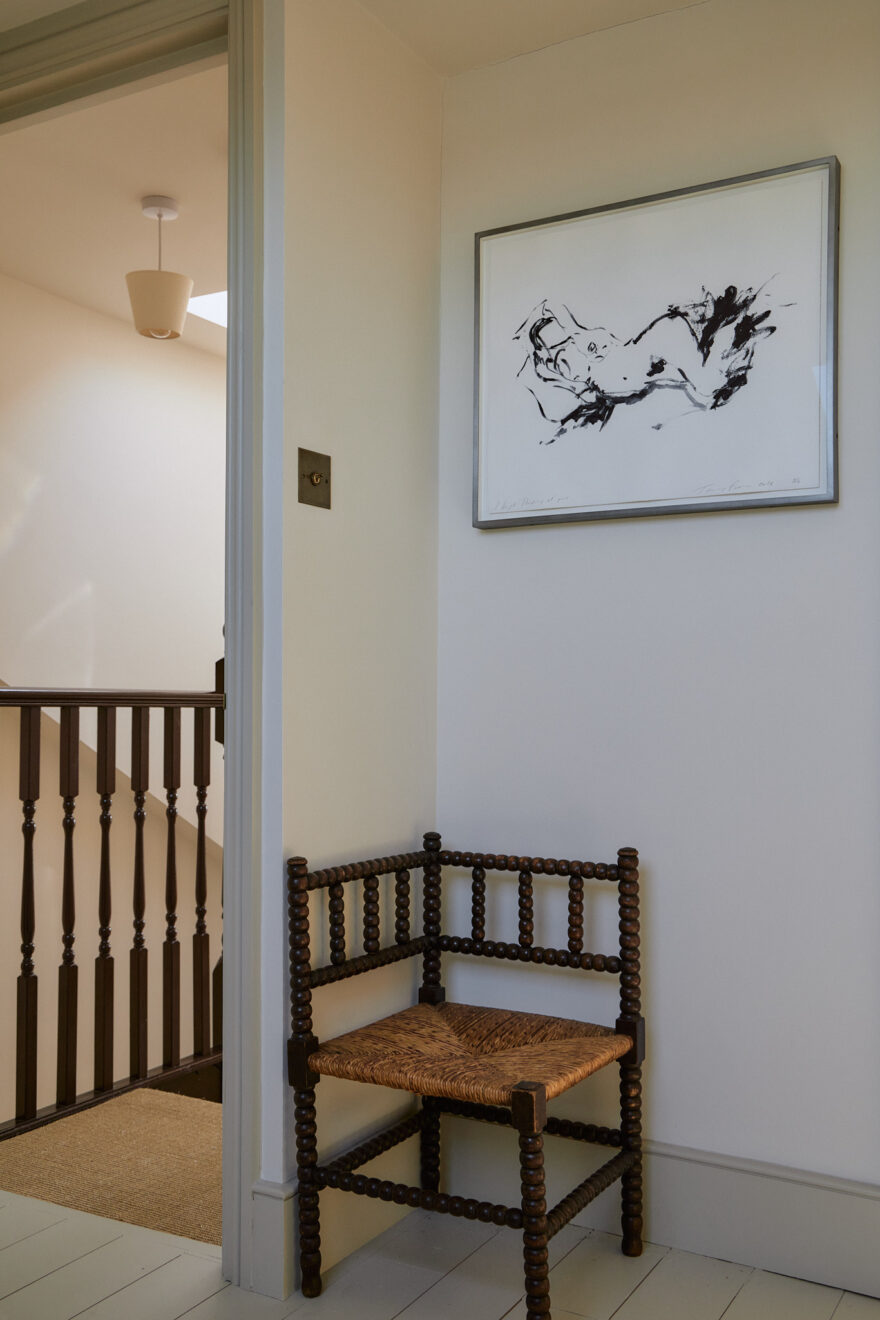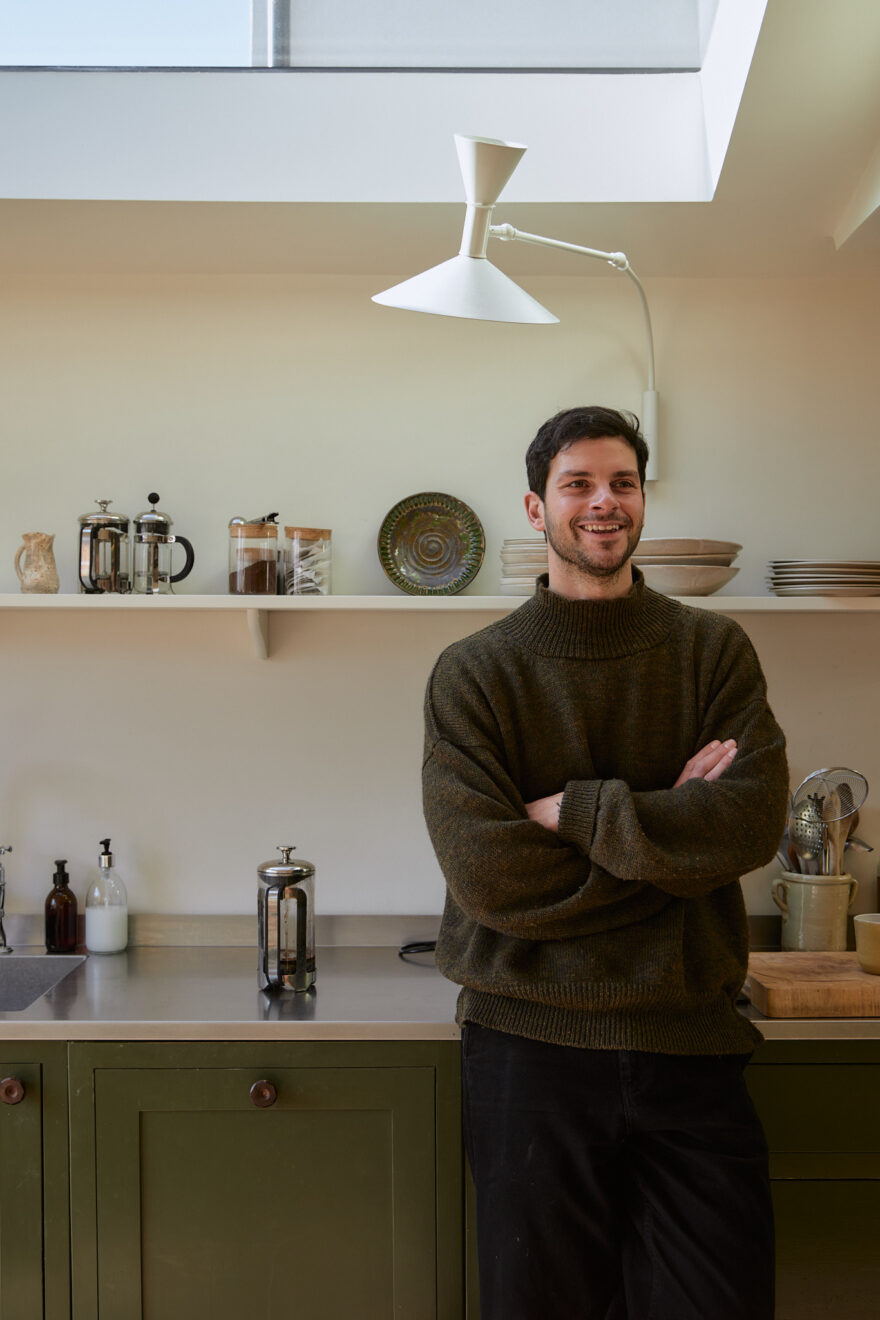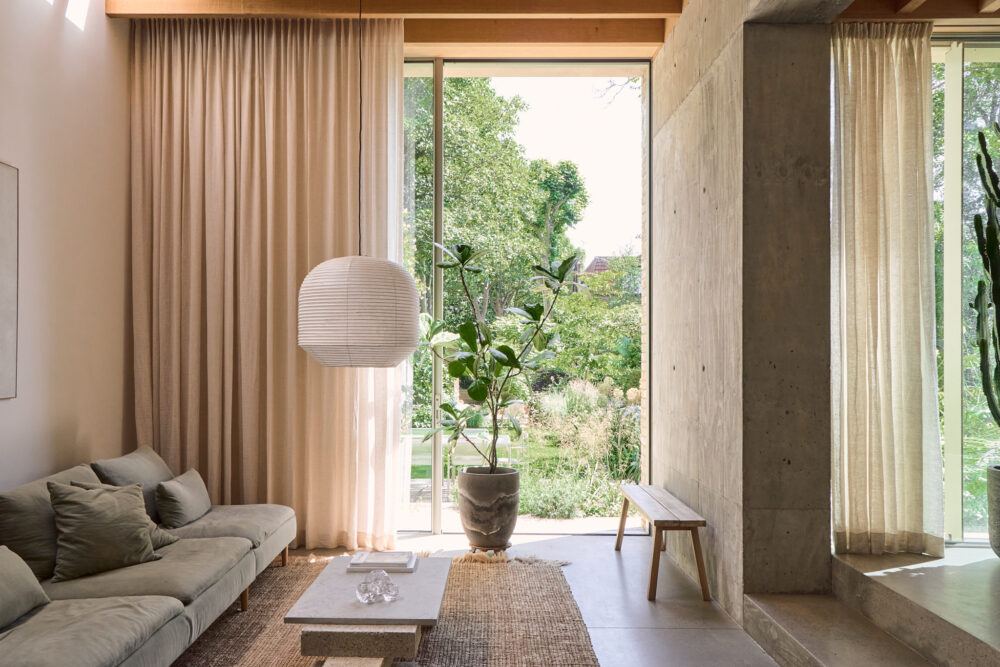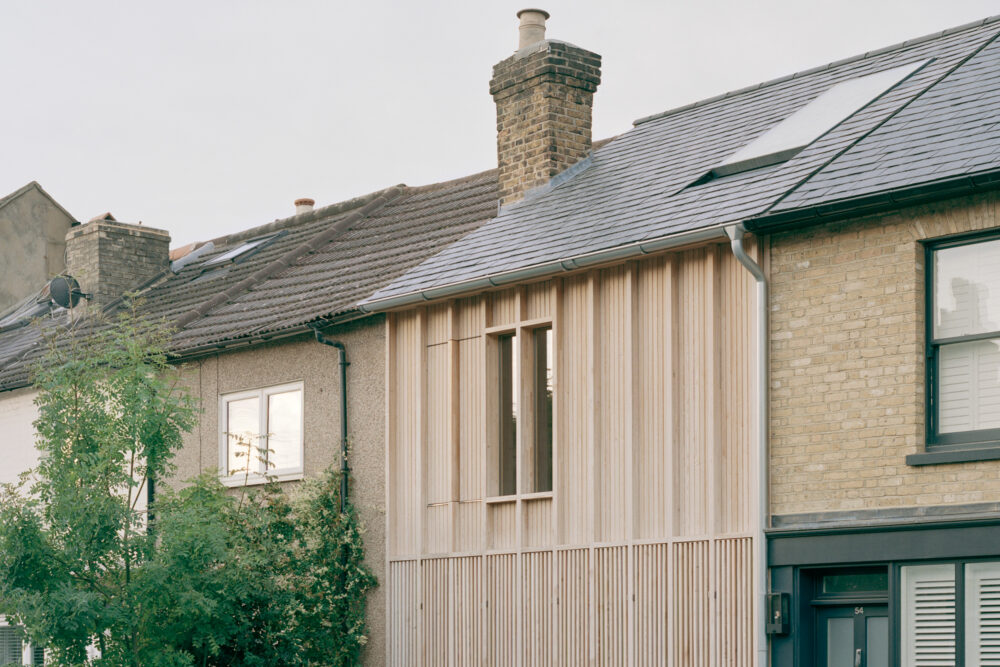At Home With Dom Hamdy
Words by Darcie Imbert
Dom Hamdy is the rising star of London’s food scene, the meticulous mind behind some of the most talked-about restaurants — Bistro Freddie, Crispin and the newly opened Canal — loved in equal parts for their honest food and buzzy dining rooms, each talking their own distinct design language. Beyond bustling kitchens and thoughtfully designed spaces, there’s another place that Dom pours his attention into: his home.
We spent a day with Dom in his East London terrace, reflecting on the journey that led him from Hackney to his current home in Leyton – a place that has become a canvas for his sharp eye for detail, and the backdrop to many convivial dinner parties. Leaving behind the familiar rhythm of London Fields and Haggerston meant more space for a growing family, and the flexibility to build the house that supported their needs, both functional and aesthetic. The renovation, guided by his architect brother, was focused on the fundamentals: the pursuit of light, the flow of space, and the honest, untampered beauty of natural materials. Together, they have created a home that supports the motions of family life while adhering to their shared design sensibilities — a home that’s full of life, with stories quite literally etched into its bones.
I was living in Hackney for a long time, eight or nine years. My wife and I got pregnant, and with a baby on the way, we needed more space. So it felt like a sensible time to move slightly further out of Hackney. For what we could afford and wanted – a terrace house and to do some renovations – Hackney wasn’t really an option.
This is actually the first house that we viewed. It was in relatively good condition but still needed the kitchen extension and loft conversion. It felt manageable. Once you start stripping everything out and replastering, putting in new radiators, and rewiring, the starting point doesn’t matter. We were on a very tight schedule because our daughter was on the way. My brother, an architect who worked for Norman Foster for a long time, helped us with the design.
The light. We were desperate to find a south-facing house. Light is really important to us. And ceiling height; we’re lucky with the rest of the house as the ceiling height is quite high.
Interestingly, we went back and forth on whether to add a step to create a different level from the entrance and living space to the kitchen. It ended up being that we could do a 100mm step or nothing, and we wanted a couple of steps down. Ultimately, we decided it would probably be a trip hazard if it was 100mm, and our daughter would be running in and out. That was definitely a consideration. And then just choosing to have an open space.
I think it’s an interesting terrace house in that the entrance is on the side, not the front. Although the house is quite narrow compared to a lot of terrace houses – it’s a small two-up, two-down size – because the entrance is on the side, you don’t have the corridor at the front. It also means we can have this completely open-plan living, which isn’t very common for these terrace houses that are often chopped up with a corridor.
Being able to cook and see our little one playing in the living room was key. Garden-wise, it used to be a garage and was made into an office. We liked the mirroring of the Douglas Fir windows on both sides, which makes it feel like a small urban garden. For what we need it for, it’s a good setup, and low-maintenance gardens are definitely preferable.
We’ve been together for 14 years, so we have aligned over time. We are very muted in our colour choices and quite material-driven. We like natural materials: stones and woods and that tactile feeling. We spend a lot of time thinking about the things you touch in the house, like these bespoke walnut-turned cupboard handles with a scorched edge, or the solid brass door handles upstairs. Just the feeling of things, what you touch, the warmth of it – things feeling solid is important to us. Otherwise, we tend to choose relatively muted colour palettes, lots of linens and wools; we bring colour into the house through artwork rather than fabrics.
In our house, things develop a life of their own; we don’t mind coffee stains. My daughter started drawing on our coffee table, and I thought, “You know what? This is fine”. We’ll just sand it off at some point if we want to, but it’s fine.
Not really. I come from a family of medics and hoteliers. But my parents were always renovating and building their own houses and are very obsessed with visiting furniture shops on the weekend. It’s ingrained in us to look at these details and aesthetics.
I was in Yorkshire until 15, then we moved to Oxfordshire, and then I moved to London when I was 18. My mum is German, and my dad is a mix of Armenian, Russian, and French. They grew up in Alexandria in the 60s and 70s, a really cosmopolitan place. My mum grew up in a hotel, and we used to go there every summer. They went to French-speaking schools, so we spent a lot of time in France growing up. My godfather is a monk in a rural monastery in France, which was designed by John Pawson. There are lots of different influences. Maybe the hotel side is where my parents’ interest in design, interiors, aesthetics, and architecture comes from. It’s definitely filtered down.
It’s a real mix. There are some inherited pieces, like this desk which belonged to my wife’s grandparent who was a GP from Bradford. It was made by Robert Thompson, who was known as “Mouseman”, a furniture designer where apprentices learn to carve a mouse on the side for the first six months before building furniture.
There are also pieces from the restaurants: some from Barnaby Lewis, something from Andrew Pierce Scott – a lamp. The vase is by Dean Edmonds, who makes lots of obscure stuff in steel. We like Pinch a lot. The kitchen is all bespoke, made by Guy in Yorkshire. There’s also a mix of furniture, including some mid-century pieces.
We have been collecting over the years. A lot of the bits we have, we’ve had for 10 or five years. There’s this analogue table lamp by Elliot Barnes that I love; you light the candle, and it glows. Also, bits by Jermaine Gallacher, who designed three of the restaurants. I got in touch when looking to open Bar Crispin and wanted an idiosyncratic-looking wine bar. He definitely has his own aesthetic, which I respect.
I obviously have a British upbringing, having spent most of my life in Yorkshire. Then there is this very heavy French influence. My dad was diagnosed with pancreatic cancer a few years ago, so we decided the next restaurant would be an homage to him, something that speaks to him, a restaurant he would love. Freddie is his name, so that’s where the idea was born. Two years after his diagnosis we had lunch together at the restaurant which was really special, he loved it.
We initially looked at doing a British menu, but there were so many French dishes, sauces, and elements we wanted to draw in, so it naturally developed into this French-British amalgamation. I look at it as a love letter to France from Britain. You have nostalgic dishes like pies, chip shop curry sauce, sticky toffee puddings, but also classic French dishes like terrines, bavette steaks with peppercorn sauce, and choux pastries. It’s a real mix.
Massive. I think that was the thread that ran across all these different cultures: German, French, North African, and British. The thing that linked them was mealtimes and food. My parents would have dinner parties all the time, and my dad was obsessed with cooking snails. At every dinner party, he’d cook six or 12, which was very exotic for Yorkshire in the 90s.
We host a lot. Since having our little one, it’s either a very early lunch or a late dinner after she’s gone to bed, but it really varies. We’ve had all our managers from work here for a big get-together, and lots of friends come round all the time for breakfast or other meals. They’re very free affairs where everyone chips in. They’re relatively simple; we don’t do fancy, intricate dinners, it’ll be a one-dish type of thing where everyone digs in and passes it around. Just convivial lunches and dinners with a nice energy. The joy of sharing a space is really important to us, that feeling of hospitality and nurturing people by feeding them is a big way we connect.
I was studying languages and started a scotch egg stall, hand-making them in our student flat with a friend. Then we started trading at Borough Market, doing wholesale, and then opened a coffee shop when the speciality coffee boom was happening. We were looking for another coffee shop when Crispin happened. We walked past it, pitched for it, got an alcohol licence, found a chef, and it just turned into this restaurant. It’s gone from there, really, totally by accident. I wasn’t planning to become a restaurateur at all; it just speaks to me.
There are so many interesting elements to a restaurant, whether it’s the design, music, space, crockery, product, wine, food, or people. The endless number of things you can focus on is fascinating. A restaurant is a real sum of its parts, with many touchpoints that contribute to the experience, even things you don’t necessarily notice, like how the menus feel, the room temperature, the music level, or the service.
I love detail; I’m obsessed with the things that make up a space that not everybody notices on a conscious level, but you do notice subconsciously. Take John Pawson’s architecture, for example. People might think of a minimalist space with white walls and lime-washed wooden floors, but it’s so much more detailed than that. It’s the simplicity of the light and the shadow gaps instead of skirting boards, and the materiality. It looks so simple, but it’s incredibly detailed. I love that.
The biggest thing was having a really good extractor fan above head height so I could cook, get a pan super hot, and put a steak on, which I hadn’t had in any house before. So we live with a slightly noisier extractor that actually works and keeps the space clean.
Space was important, like a sightline down into the garden from the rest of the house. The island lines up with the rest of the furniture. We wanted a soft-seating breakfast area and couldn’t decide on induction or gas, so we found something with both.
A stainless steel worktop on the cook side was essential, with a massive built-in sink. Domestic kitchens never have sinks big enough to fit an oven tray, so we specced the biggest one we could find. That definitely came from the restaurants: having a big sink and worktops where you can put a hot pan down without worry.
Having the sink and the cutlery drawers right next to the dishwasher was essential for efficiency. We love our Fisher & Paykel fridge too. At some point, I’d like to get a big Lacanche range, but with the house’s value, it’s only worth spending so much; we’d have to take it with us if we moved.
It’s an amalgamation of so many things, and it can be different. It’s not like there are primary elements every good restaurant has. Some might have poor service but a beautiful setting and rudimentary food using local produce that is super honest. It just depends. I think what makes a great restaurant is the experience you have when you’re in it, which isn’t necessarily just down to the restaurant but also who you’re with, how you’re feeling, and the energy. I love the idea of restaurants being transportive places. You walk through a curtain and are transported from the rest of your week, to another place, another time.
Both. I definitely go back to favourites because they make me feel comfortable, they know you, and you have a connection to them. But London is an amazing place to eat out; it’s endless. My visit to Quality Chop House recently was amazing. I love Maison François, Brawn is great, Kiln. There are so many places.
We have a very early start every day, like 5 am. We have breakfast together in the morning, might go for a walk if the weather’s good. The Leyton flats aren’t that far away. Just lots of family time, seeing friends, cooking, reading. We go for a coffee and pastry in the morning at Yardarm, the closest place on Francis Road. Might go for a swim, exercise, or just have a bath in the sunshine. Getting a bathroom with a window was another thing; it feels like I’ve never lived in a house in London where the bathroom has had a window. You can have a bath and see the blue skies. It’s amazing.
We always have breakfast and dinner together. That family time around the table is key for connecting and engaging. Then just read before bed, really, keeping it relatively calm. Monday to Thursday, I’m out, going from restaurant to restaurant, catching up with all the GMs and head chefs, and cycling around.

